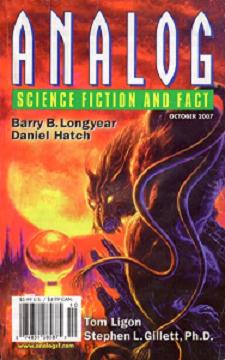 “An Angel-Headed Hipster Escapes” by Daniel Hatch
“An Angel-Headed Hipster Escapes” by Daniel Hatch
“El Dorado” by Tom Ligon
“The Hangingstone Rat” by Barry B. Longyear
“A Bridge in Time” by Joseph P. Martino
“Virus Changes Skin” by Ekaterina Sedia
“On The Quantum Theoretic Implications of Newton’s Alchemy” by Alex Kasman
Reviewed by Nader Elhefnawy
The first story, Daniel Hatch‘s intriguingly titled novella “An Angel-Headed Hipster Escapes” centers on Jonathan Bender, a twentieth century astronomer now trying to make his way in the world as a “post-human” in a somewhat more complete sense than the label tends to imply. (In this case, Bender’s brain has gone on living in a specially equipped box–an “Organic Memory Storage Device.”)
Much of the story’s interest comes from its being told from Bender’s viewpoint inside that box, though Hatch’s careful control in this regard wouldn’t help much if the story wasn’t worth telling. Fast-paced and full of action, as well as flashes of wit, it is also interesting from a world-building standpoint, containing plenty of interesting geopolitical, technological and cultural speculation, with the most striking touch the “Sky City” which has sprung up on an incomplete beanstalk in Ecuador. The story is diminished somewhat by an anticlimactic (though logical) conclusion, but on the whole is the strongest narrative in this issue.
Tom Ligon‘s “El Dorado” features that classic Golden Age figure, the prospector out among the asteroids, one Victor Gendeg in this case. Here he finds his own El Dorado in a particularly rich rock just as a mysterious, unambiguously alien signal arrives in our solar system, trailing crisis in its wake.
Ligon’s story is impressively meticulous in its working out of the technical details of its central problem, but it is also very exposition-heavy (much of it related in the monologue of a solitary Victor), the novelette’s ultimate direction becomes fairly predictable early on, and the last scene is a bit too talky. The reflection on the real nature of heroic acts is timeless, but here less would have been more.
Barry B. Longyear‘s “The Hangingstone Rat” brings back Inspector Harrington Jaggers and his partner Guy Shad from his previous story, “The Good Kill” in the November 2006 issue (which introduced this future where human consciousness is downloadable into often quite fanciful artificial beings). This time Jaggers and Shad go out on a call when a hiker finds a dead rat “bio,” and are promptly caught in an explosion that seems to Jaggers to be something a lot more insidious than an old dud artillery shell. What Jaggers finds when he gets to the bottom of it is fairly standard stuff as murder mysteries go, but the plot twists and touches of humor provided by the posthuman elements add interest.
Joseph P. Martino‘s “A Bridge in Time” assumes a world in which time travel technology has become so ubiquitous it is used to reroute traffic. In this particular instance, a bridge over a ravine is closed for an hour in the early morning of each day, and time gates positioned at each end to enable cars to cover the distance during the interval. (Put simply, the car drives into the time gate in its time, emerges on the bridge in the story’s time period, drives to the time gate at the end, and goes back to its own period. If you’re having a hard time picturing it this may be because, as Doc Brown would say, “You’re not thinking fourth-dimensionally!”) As in quite a few time travel stories (not least of them Doc Brown’s), someone seems to be trying to sneak information back to this time which sets up the story’s mystery.
“A Bridge in Time” does a good job of charting the paradoxical, often dizzying implications of this kind of ubiquitous time travel technology. However, Martino’s storytelling might be a little too efficient. Almost every word of the dialogue directly relates to the technical problem at hand, which becomes problematic because the story ultimately hinges on the human element, and the relationship between Time Gates Inc. maintenance engineer Tom Carson and Jennifer Campbell is a bit too thinly sketched for the purpose.
Ekaterina Sedia‘s “Virus Changes Skin” goes to almost the opposite extreme in approach. In the future the story sketches, Earth’s population has been decimated by ozone holes and global warming, AIDS and Ebola. The central figure, a scientist named Willow Robertson, opts to change her racial identity back from white to black after her mother’s death (her parents having genetically altered her appearance when she was very young).
Rather than an environmental, epidemiological or racial drama, however, Sedia’s story is a meditation on the role viruses play in our world, culminating in Willow’s taking an almost Taoist attitude toward them. While the story’s handling is graceful, at bottom its speculative element makes it the kind of “Frankenstein” story that Isaac Asimov defined himself against, and the reader’s attitude to that take on science will strongly affect their response to it. (For me, flowing with “the way” of the virus is just a bit too much to ask.)
The last story in the issue, Alex Kasman‘s “On The Quantum Theoretic Implications of Isaac Newton’s Alchemy,” like J. Gregory Keyes’ Age of Unreason novels, spins a story out of the idea that perhaps there really was something to Newton’s alchemical endeavors. Playing it principally for light comedy, it centers on a mathematician who finds himself on that margin where the cutting edge of today’s theoretical science easily becomes a jumping-off point for fantasy. While not especially subtle, it works on its own terms.